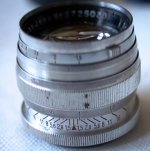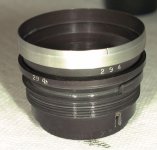Brian,
Obviously, I agree with you that a stamp on a block lens gives the evidence of its aristocratic origin. Although, we know very well that optic elements can be switched with J-3. So Sonnar purists can never be sure which one is ginuine, and which is a Russian copy. There is no way to tell one from another considering that first ZK and J-3 from the 50's had German glass. Actually Russian made optics was not worse or even better than the original Sonnar particularly in 50-60's. Perhaps a shade of the coating may help here, but one should know what color the original Sonnars is!
It is true by the end of the war there were lots of bizzare "home-made" lenses. However, they all had in common one little thing -- a typical German (Sonnar) style to engrave numbers! Some ZK's continued to keep this style. Most likely there were Germans who set up the engraving process and worked on the Krasnogorsk factory. J-3 barrel engraving is much different -- one may check the "2", "4" and "7" and it becomes clear. Actually, the infinity character is also different on J-3. Being Russian I know this for sure -- we write numbers slightly different and it is reflected on the lens barrels of Russian made lenses.
The distance scale barrel of the lens in question comes from J-3! Having CZJ Sonnar, ZK and four J-3 from '51 to '56, I can tell one from another just from engraving style. BTW, you can check this on your pic of J-3 and CZJ Sonnar as well!
Although, you may be correct and the block lens of this "Sonnar" has a Sonnar stamp 🙂))
What counts in the end if this lens works as it should or it's just a paper weight!



